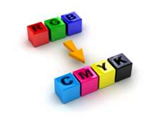More than just a resource for customer inquiries, can find answers to questions without sending an email and placing a call
Printing FAQ
More than just a resource for customer inquiries, can find answers to questions without sending an email and placing a call
This is hidden
This is hidden
RGB - CMYK - CIELab: what are they?

RGB refers to the colors red, green and blue, which is the colour system used by most imaging devices such as cameras, scanners & monitors.
Many printing systems, including offset and digital prints images using a different set of colors: cyan (blue), magenta (red), yellow and black (CMYK).
Files created in RGB must be converted to CMYK before they can be printed on a four-color press. (Follow the instructions provided by your design program.) Keep in mind that files viewed in CMYK provide a more accurate representation of how your printed piece will look than what you can see in RGB mode. If you are not familiar with RGB-CMYK conversions, do not attempt it. We are happy to do it for you.
What is the difference between offset and digital printing?
Offset printing is a widely used printing technique where the inked image is transferred (or “offset”) from a plate first to a rubber blanket, then to the printing surface. Based on the repulsion of oil and water, paper obtains ink from ink rollers, while the non-printing area attracts a film of water, keeping the nonprinting areas ink-free.
Digital printing is a widely used, plate-less system that involves the reproduction of digital images on a physical surface, like a copier. Each cycle of the printer transfers a fresh image – same or different – to the substrate.
How do I choose between offset and digital printing for my project?
If you have a very short run project, i.e. a handful of specialty posters, digital printing is a more affordable, effective option. Because digital printing does not require plates, initial set-up costs are much lower. This is especially the case when your short run project involves four or more colors. In addition, digital printing makes it possible to print variable information from print to print, which conventional printing cannot do.
For other projects, offset printing provides many distinct advantages, including:
- Consistent high image quality on short and long run projects
- Usability on a wide range of printing surfaces in addition to smooth paper (e.g., wood, cloth, metal, leather, rough paper)
- Quite simply, the beauty of ink on paper
What file formats do you accept?
To ensure the accuracy of your printed piece, it’s best to upload your project as an Adobe PDF (Portable Document Format) file. By nature, PDFs create print-ready files and provide a preview of your project that is as close to the final printed piece as possible.
If you do not have PDF conversion software, go to PDF Conversion for a link to a free converter tool.
In most cases, we also can work from the following file formats:
- Adobe Acrobat
- Adobe Photoshop
- Adobe Illustrator
- Adobe InDesign
- Adobe Pagemaker
- Macromedia FreeHand
- Quark Xpress
- Microsoft Publisher
- Microsoft Powerpoint (must be converted to a PDF before uploading)
- Microsoft Word (must be converted to a PDF before uploading)
How do I choose an appropriate paper for my offset printing project?
Glossy Vs. Matte: Glossy papers convey quality and sophistication, and they make photos “pop,” but their shine also can make text harder to read. Matte papers project an “environmentally friendly” image, and their soft white appearance makes for good text legibility.
Light Vs. Heavy: Lighter weight papers say “value” and are economical for mailing, while thicker papers typically are more opaque and more durable, making them a good choice for pieces that feature a lot of text or are intended to have a long shelf-life.
What resolution is right for my images?
Because offset printing is extremely precise, any images you include should be provided in a minimum of 300 dpi (dots per inch) at size (100%). Images that are of a lower resolution are likely to be blurry or will appear “broken up.”
How can I reduce the file size of the artwork I want to upload?
We recommend that you compress file using WinZip for PCs and the Apple zip process or Stuffit for Macs. This decreases the file size and the chances for file corruption.
How well will my job match what I see on my monitor?
Because computer monitors vary, PDF proofs can be used to help display layout, text accuracy, and image placement and proportion, and to give a fairly accurate interpretation of color or density. Although we make every effort to match colors and/or ink densities as shown on PDF proofs, we cannot guarantee exact matches between our offset printing proof and the PDF proof you print from your office or home printer.
What should I look for when I get my proof?
When you retrieve the PDF proof we provide, please review it carefully. This is your opportunity to check your layout and graphics, and your last chance to find typographical errors or misspelled words, and mistakes in grammar, punctuation and content.
Can you print smaller quantities?
To obtain the best prices possible we have our orders printed in bulk, which means certain quantities have been set on specific types of printing products available. Typically, the minimum printing quantity is either 500 or 1000 copies, depending on the item.

